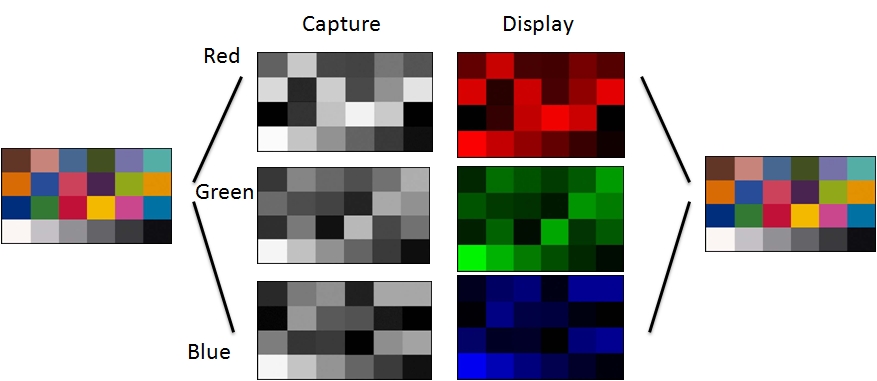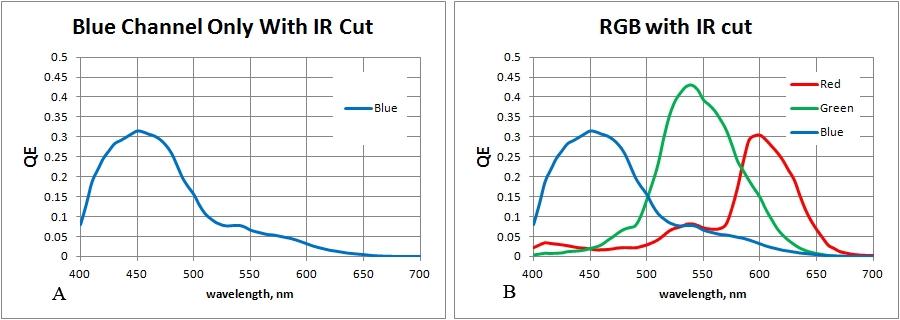
Figure 1, capture and display.
There are many ways to capture three images. The conceptually straight forward way to capture three images uses a beam splitting prism to separate a single full color image into three spectral component images. Three monochrome imagers are placed where the color images emerge from the prism. Practically, a beam splitting prism camera is difficult to build and all three imagers have to be adjusted so the image is in focus on all three imagers at the same time. The imagers also have to be aligned in X, Y, and rotation so that image features fall on corresponding pixels on all three imagers.

Figure 2, camera with beam-splitting prism.
It is more common to apply different color filters in a pattern on individual pixels using microelectronic fabrication techniques. The filter pattern is called a color filter array (CFA). The most common common CFA is the Bayer pattern. It is a two by two pattern tessellated over the surface of the imager. Figure 3a is an example of the two by two pattern, figure 3b is an example of the two by two pattern tessellated over a small area. A process called interpolation or demosaicing isused to reconstruct the color image.

Figure 3, Bayer pattern.
To simulate a single imager with a CFA pattern three images are created each with the spectral response of the imager cascade with the spectral transmission of one of the color filter array patches. The QE for just the blue channel is shown below in figure 4A. Red, green, and blue QE curves are shown in figure 4B.

Figure 4, red, green, and blue quantum efficentcy.
To generate a color Bayer image three monochrome images are generated using the red, green and blue imager QE. Pixels corresponding to the appropriate color and location in the pattern are assembled to form a simulatedBayer image. This is shown schematically in figure 5.

Figure 5, schematic for the conversion of a color image to a simulated Bayer pattern image.
The value of each pixel in the simulated Bayer image is the number of electrons that the pixel would have collected. The image does not contain noise up to this point. This is a monochrome image so noise is applied to the image in the same way it is added to a monochrome image. After the noise is applied the image can be converted to a color image. Simplistically the image can be separated, pixel by pixel, into red, green, and blue pixel images. The images can then be re-sampled using bi-linear interpolation to build three separate images the same size as the original imager. Ignoring noise cleaning and color correction,each image is displayed with the corresponding color, red, green, and blue. The images below are simulated color images of a 24 patch Macbeth target with Poisson noise. The pixel size is 1.5 micron square. The images are 640 by 480 pixels. Notice the ISO 100 image (figure 6) has much lower noise than the ISO 1600 image (figure 7) because each pixel collects more photons at ISO 100. The noise in the color images is higher in both cases compared to the monochrome images because the color filter array absorbs roughly two thirds of the light, in addition the noise in each color channel is not correlated so the noise is colored. This makes the noise more noticeable.

figure 6, ISO 100 image.

Figure 7, ISO 1600 image.